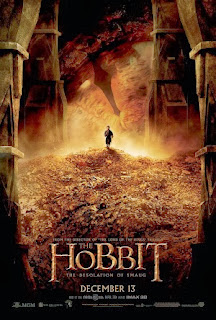"It never ceases to amaze me, the courage of hobbits..." - Ken Scott
The journey of the 13 dwarves of Erebor and one hobbit from the Shire continues. An Unexpected Journey proved to be a disappointment for many, and chances are that The Desolation of Smaug
will continue to disappoint, given that this is still a heavily-padded
and overblown account of a short novel that was once a short cartoon.
They've really tacked on a whole bunch of embellishments, including new
characters and subplots, that simply aren't in Tolkein's The Hobbit. If it wasn't clear before, it should be clear now that the Hobbit films are more like a massive compilation of bonus adventures for film fans who adored the Lord of the Rings films.
As one of those viewers, I personally welcome the expanded narrative and
universe, no matter how absurdly thin the plot is spread out. At the
time of this writing, The Desolation of Smaug has got to be the most epic and action-packed film of all the Middle-Earth films to date (second only to The Lord of the Rings: The Return of the King).
The film wastes little time in getting the ball (or barrels) rolling;
it picks right up with everybody being chased by orcs, giant spiders,
and wood elves. I always thought that the barrel scene was clever in
the book, but the film takes it to a whole new level. The wood elves (among which, one familiar face
appears, and Turiel might be a new favorite heroine) pull off some
insane fight moves, the likes of which I can only describe as some kind
of crazy elfin kung-fu (elf-fu?). The film maintains tension throughout
the Laketown and Erebor scenes, before finally bringing the heroes
face-to-face with Smaug. This massive dragon is easily one of the most
menacing villains of all time, and the last act of the film is a long
and exhausting sequence in which all the characters slide down mounds of
treasure, bash through walls, and careen through underground mines,
while being pursued by this fire-breathing monstrosity. And that's not
all either: while all this is happening, Gandalf comes face-to-face
with another evil opponent, and his scenes are impressively epic as
well.
Then...THEN...the film ends. Of all the excesses this film goes
through, it's the sudden stop at the end that I find most bothersome;
it's every bit as disappointing as cutting off a piece of music before
its crescendo. On the inevitable home video release, this won't be much
of a problem, since you'll probably just be able to pop in There and Back Again and continue the action. In the cinema, I sensed a collective disappointment in the knowledge that we'll have to wait one more year before
seeing the actual battle of Laketown, in addition to wrapping up every
other conflict that's left hanging (and a LOT is left hanging). The Lord of the Rings: The Two Towers
was able to stand on its own, with a full climax at the Battle of
Helm's Deep; if that battle's conclusion was cut off and left for The Return of the King, then you can imagine how it is with The Desolation of Smaug.
There are other issues that might throw viewers off: there are quite a
few scenes where deus ex machina are in full swing, with characters
appearing as convenient. The film still plows through a bunch of
subplots that might not really seem necessary (although, the whole
Necromancer thing seems more tightly developed now).
Regardless, the film still adheres to the fundamental plot structure of The Hobbit
novel. It's very much a one-thing-leads-to-another structure. What
matters the most are the characters; Bilbo seems to be in the spotlight
more, with more maturity and strength being explored. The dwarf
characters show even more nuances of their own. Various other
characters have their moments, and it is especially intriguing to see a
lot more to the Bard and the Laketown drama. There are numerous
connections drawn among all the different characters and tangents, and
the larger structure of all six Middle-Earth films is much more
apparent. At its core, the film still explores key themes involving the
adventure of life, the corruption of greed, and the classic struggle of
good-vs-evil.
As before, this film is made with exceptional skill. Photography and
editing continue to be superb. Acting and writing are still top-notch;
Martin Freeman proves to be quite impeccable as Bilbo, Richard Armitage
still plays it tough as Thorin, Benedict Cumberbatch is truly menacing
as the dragon's voice, Evangeline Lilly is both lovely and badass, and
Luke Evans is alright. You also can't go wrong with Ian McKellen; the
man really IS Gandalf the Grey. Writing is as good as ever. This
production uses great-looking sets, props, costumes, and special
effects. Music is still good too.
This is still quite a bloated saga, but I personally don't mind one bit.
The spectacle is huge, the storytelling is still very tight and
engaging, and the film is still very well-made. It's only a shame that
the film ends the way it does. Regardless, if The Hobbit series follows in the same path as the Star Wars prequels, I have no doubt that There and Back Again
will be the best of the lot, and one hell of a spectacle. This is
still just the middle part of the saga; there's still more to take care
of in the Middle Earth.
5/5 (Entertainment: Perfect | Story: Very Good | Film: Perfect)


No comments:
Post a Comment